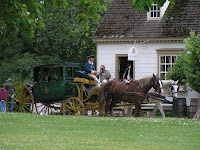
Colonial Williamsburg (http://www.history.org/) was our destination for Wed.’s side trip, and is a combination of historical landmark and living history museum. Arriving at the visitor center, we had the option of paying at minimum $37 per person for a tour ticket or $2 per person to take a bus to the restored historical town and guide ourselves. We opted to take the bus. Cars are restricted from the restored area, but
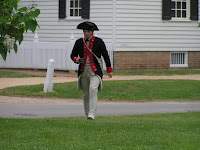
anyone can walk through the historic district of Williamsburg free of charge at any hour of the day. The only downside to not purchasing one of the pricey tickets is that you aren’t allowed to go into a lot of the buildings, but Russ’ philosophy is that once you’ve seen one old building, you have seen them all. :-) Before boarding the bus, we watched a short film ($3 per person) called “The Story of a Patriot”, which was
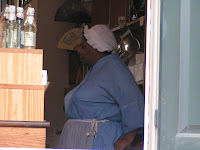
made in 1956 and starred Jack Lord (of Hawaii Five-O fame). Charles Laughton also had a small role. It was quite interesting and follows the story of a Virginia Assembly member during the crucial period when the colonists resisted British taxation without representation, met force with force, and chose revolution.
After the movie we boarded the bus that took us to the town’s entrance where you had the option of walki
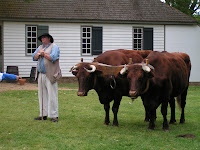
ng or changing to another bus that would take you from stop to stop throughout the town. Scott decided to ride while Russ and I decided to walk and meet him at one of the stops ahead. Colonial Williamsburg is an open-air collection of buildings populated with historical reenactors whose job it is to explain and demonstr
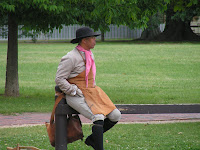
ate aspects of daily life during colonial times. The reenactors work, dress, and talk as they would have in colonial times.
For an additional fee (on top of the $37), you’d also have admittance into the section of town called Revolutionary City where late in the afternoon actors bring the Revolution to life on the streets of Colonial Williamsburg from 1774 to 1781. It’s an interactive program and probably would have been fun and interesting to see but was just too pricey and not a separate fee option.
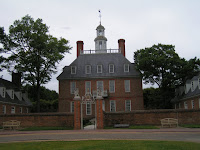
As Russ and I began our walk into town, the first place we saw was the Governor’s Palace. As Williamsburg was the capital of VA before Richmond, the Palace was the residence of 7 royal governors and the first two elected governors of VA, Patrick Henry and Thomas Jefferson. The entrance gate pi

llars are topped with the lion of England and the unicorn of Scotland (both parts of the British coat-of-arms) carved in imported stone. Of course we hadn’t purchased the pricey ticket so couldn’t enter the palace, but it was still a beautiful sight to see from the outside.
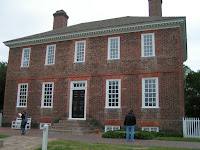
As we continued our walk, we passed the home of George Wythe (pronounced with), who was a friend of Thomas Jefferson and the first Virginian signer of the Declaration of Independence. All along the streets are various period shops and taverns as well as private homes and offices, all keeping with the period architecture.
From there we came across the Bruton Parish Chu
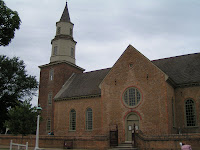
rch (
http://www.brutonparish.org/history.htm), and surprisingly this building was open to the public at no additional charge. The churchyard is full of old tombstones with some even dating back to the late 1600s. The minute we stepped inside the church, we recognized it as the one we had seen in the movie we just watched. It is an Ep
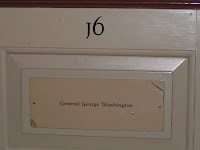
iscopal church and has been in use since 1715 and still serves an active congregation of nearly 2,000 members. George Washington, Thomas Jefferson, and Patrick Henry attended when the legislature was in session, and name plates on its box pews commemorate these famous worshipers. The church still uses a bell cast in 1761, which rang to celebrate the signing of the Declaration of Independence in 1776 and the Treaty of Paris ending the Revolutionary War.
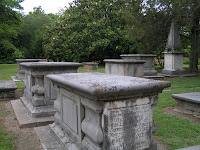
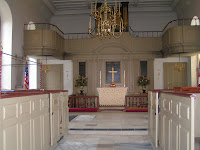
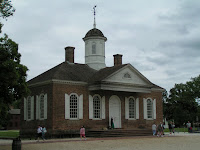
Next we passed the Courthouse (where the Declaration of Independence was read from its steps, and the Treaty of Paris was announced), and the Magazine (used to store the arsenal and equipment necessary for protection). Then we caught up with Scott, and it was time for a bite to eat at Josiah Chowning’s Tavern, a casual eating place where Scott tried his first mint julep. From here we split again, Scott taking the bus for the remainder of the loop around town while Russ and I walked back to the bus stop that would take us all back to the visitor’s center.


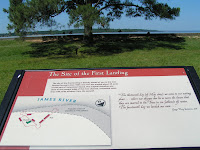
Thurs. we traveled to Jamestown (http://en.wikipedia.org/wiki/Jamestown,_Virginia), the first English settlement in North America and first capital of Virginia. On May 14, 1607, 104 men and boys landed on the banks of the James River near the mouth of the Chesapeake Bay and built James Fort from whence the United States of America eventually evolved (thus giving it the name “America's Birth
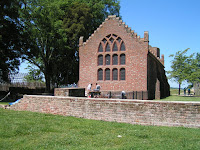
place”). Two of the men on this initial voyage were Captain John Smith (
http://www.apva.org/history/jsmith.html), and a colonist named John Rolfe, who introduced a strain of tobacco which was successfully exported in 1612, and two years later married Pocahontas.
Histo
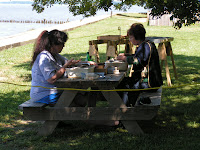
ric Jamestown is operated by the National Park Service and the Association for the Preservation of Virginia Antiquities (APVA). Visitors can view the site of the original 1607 James Fort, the 17th century church tower, and the site of the 17th century town. Much of the town and fort had been buried for years from neglect, the Civil War, weather, and farming, but through their efforts, thousands of artifacts have been found a

nd many are housed in the Archaearium (ark-e-air-e-um) Archaeology Museum located on the property. The Jamestown Rediscovery Project, begun in 1994, has located over ninety percent of the 1607 fort on land, and in fact were busy excavating while we were there. Several people were digging near the church and at the site of the fort, a couple ladies were seated at a picnic table washing pieces from dirt pulled a couple days earlier from the churchyard, and nearby the asst. curator was busy sorting and tagging the pieces. I spoke with her at length as she explained the process and how she came to be in this position.
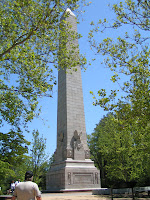
After watching a short film on the history of Jamestown, one of the first sights you see as you walk over the bridge from the visitor’s center is the Tercentennial Monument, an impressive stone structure resembling the Washington Monument in D.C., commemorating the 300th anniversary of the Jamestown. Next we came upon the 1907 Jamestown Memorial Church which has the original 17th century church tower attached and is surrounded by a graveyard. The church tower is thought to have been a part of the first brick church built about 1639. The first representative assembly in the New World convened in this church

on July 30, 1619. Russ has found it ironic that given today’s climate of separation of church and state that as we have learned at the last couple locations the founding fathers continually invoked prayer and regularly met in churches. Washington, Jefferson, and Henry along with other leaders of the American Revolution met at the Bruton Parish Churc
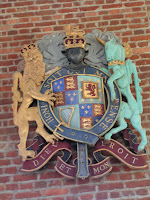
h up the road in Williamsburg. To suggest that God was not part of the founding fathers’ fundamental belief is something only the ACLU cannot see.
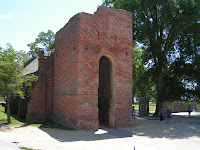
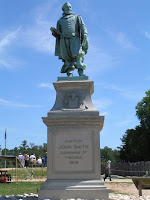
We continued on the trail passing by the statues of Captain John Smith and Pocahontas on our way to the Archaearium in front of which stood this huge wood cross erected in 1957 to honor God and the memory of those early settlers who died in the first years at Jamestown.



The Archaearium is built on the foundation of the original Statehouse and uses a series of piles and cantilevers to preserve that original foundation. When you enter there are several areas where the floor is glassed in so you can see that foundation below. We weren’t allowed to take photos inside, but I took this one outside showing some of the original foundation, but it's not as impressive as that inside the museum. Russ was ready to leave because as he says once you’ve seen a bunch of old rocks and ruins, they all look alike. But here is where we differ because as you may remember I wanted to be an archaeologist at one time, and I could have stayed there for hours and would h
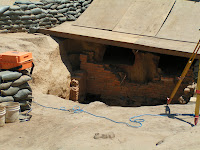
ave loved to help dig, sort, or whatever!
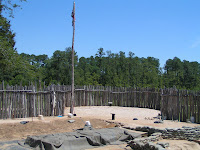
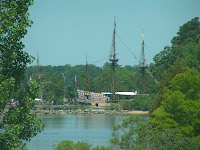
Once back at our car we took the 3 mile drive around Jamestown Island taking in the same landscape that the colonists probably encountered with all its marsh, swamp, forests, and wildlife. On our way back we passed replicas of the ships which brought those first settlers over from England. They are docked at nearby Jamestown Settlement and can be visited as part of the $13.50 admission price into the settlement, which is simply a “living museum” with reenactors recreating life in early Jamestown. Again we chose not to pay the extra money. Before returning to the campground we stopped at the Virginia Ham Shoppe because Scott wanted to get some Virginia ham and see if he could find a specific kind of bacon he’s had at various times but unable to find in stores. We picked up some Virginia ham sandwiches which were quite tasty.
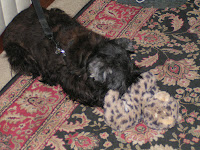
That night we had quite a scrumptious feast as Scott had finally received a shipment of homemade tamales from his former El Paso housekeeper! It has been so long since Russ and I have had any really good homemade tamales, and this was quite a treat. We supplemented it with refried beans, Spanish rice, and tortillas. What a meal! Bonnie always comes over with Scott so she can visit Mikey and Abby, and I snapped this cute picture of Bonnie playing with Abby's stuffed tiger.
Friday we left for Fredericksburg, VA, for more Civil War action and preparation for Scott’s departure as he heads for a rally in Branson, MO.

No comments:
Post a Comment